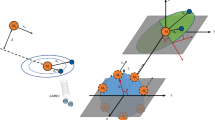Abstract
THE recent discoveries1–4 of massive planetary companions orbiting several solar-type stars pose a conundrum. Conventional models5,6 for the formation of giant planets (such as Jupiter and Saturn) place such objects at distances of several astronomical units from the parent star, whereas all but one of the new objects are on orbits well inside 1 AU; these planets must therefore have originated at larger distances and subsequently migrated inwards. One suggested migration mechanism invokes tidal interactions between the planet and the evolving circumstellar disk7. Such a mechanism results in planets with small, essentially circular orbits, which appears to be the case for many of the new planets. But two of the objects have substantial orbital eccentricities, which are difficult to reconcile with a tidal-linkage model. Here we describe an alternative model for planetary migration that can account for these large orbital eccentricities. If a system of three or more giant planets form about a star, their orbits may become unstable as they gain mass by accreting gas from the circumstellar disk; subsequent gravitational encounters among these planets can eject one from the system while placing the others into highly eccentric orbits both closer and farther from the star.
Similar content being viewed by others
References
Mayor, M. & Queloz, D. Nature 378, 355–359 (1995).
Latham, D. W., Mazeh, T., Stefanik, R. P., Mayor, M. & Burki, G. Nature 339, 38–40 (1989).
Marcy, G. W. & Butler, R. P. Astrophys. J. 464, L147–L152 (1996).
Butler, R. P. & Marcy, G. W. Astrophys. J. 464, L153–L156 (1996).
Lissauer, J. Icarus 69, 249–265 (1987).
Pollack, J. et al. Icarus (in the press).
Lin, D. N. C., Bodenheimer, P. & Richardson, D. C. Nature 380, 606–607 (1996).
Boss, A. Science 267, 360–362 (1995).
Boss, A. Nature 379, 397–398 (1995).
Beckwith, S. & Sargent, A. Nature 383, 139–144 (1996).
Gladman, B. Icarus 106, 247–263 (1993).
Chambers, J., Wetherill, G. W. & Boss, A. Icarus 119, 261–268 (1996).
Farinella, P. Moon Planets 22, 25–29 (1980).
Everhart, E. in Dynamics of Comets: Their Origin and Evolution (eds Carusi, A. & Valsecchi, G.) 185–202 (Reidel, Dordrecht, 1985).
Wetherill, G. W. Nature 373, 470 (1995).
Wetherill, G. W. Astrophys. Space Sci. 212, 23–32 (1994).
Ward, W. R. Icarus 73, 330–348 (1988).
Takeda, H., Matsuda, T., Sawada, K. & Hayashi, C. Prog. Theor. Phys. 74, 272–287 (1985).
Cochran, W. D., Hatzes, A. P., Butler, R. P. & Marcy, G. W. Bull. Am. Astron. Soc. 28, 1111 (1996).
Rasio, F. A. & Ford, E. B. Science (in the press).
Author information
Authors and Affiliations
Rights and permissions
About this article
Cite this article
Weidenschilling, S., Marzari, F. Gravitational scattering as a possible origin for giant planets at small stellar distances. Nature 384, 619–621 (1996). https://doi.org/10.1038/384619a0
Received:
Accepted:
Issue Date:
DOI: https://doi.org/10.1038/384619a0
- Springer Nature Limited
This article is cited by
-
The origin of free-floating planets
Astrophysics and Space Science (2023)
-
Exploring the link between star and planet formation with Ariel
Experimental Astronomy (2022)
-
On A Hypothetical Mechanism of Interstellar Life Transfer Trough Nomadic Objects
Origins of Life and Evolution of Biospheres (2020)





